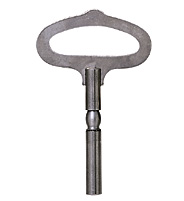-
Clock parts
-
After brand and calibre
-
Press-fit bearings
-
Pulley wheels
-
Cabinet fittings/accessories
-
Body trim
-
Weights/accessories
-
Glass bells
-
Bells/accessories
-
Chime rods/Gong springs
- Clock key
-
Hammers/accessories
-
Chains/ropes/strings/accessories
-
Cuckoo pipes/Accessories
-
Pendulum/accessories
-
Suspension springs
-
Raw shoots
-
Screws/nuts
-
Swiss anchor escapements
-
Pawl springs
-
Sperraeder
-
Drivers
-
Watch stand
-
Clock wallpaper
-
Balance shaft after U no.
-
Washers
-
Cotter pins
-
Hand/accessories
-
Central screw
-
Dials/accessories
-
Other Accessories
-
After brand and calibre


Clock key, standard version, steel, long shaft, square inside: 3.75
Product number:
334735
Packaging Unit:
1
From Stock
| Application: | 3,75 |
|---|---|
| Article name: | Clock key |
| Interior dimension Ø mm: | 3,75 |
| Manufacturer name: | 6 |
| Material: | Messing, verchromt |
| Processing mode: | verchromt |
| Special feature: | long shaft |
Manufacturer Informations
Name: Rudolf Flume Technik GmbH
Street: Hachestr. 66
City: 45127 Essen
Country: DE
Email: info@flume.de
Phone: 0049-201-18990
0 of 0 reviews
Login
No reviews found. Be the first to share your insights.
Product information "Clock key, standard version, steel, long shaft, square inside: 3.75"
For table, wall and grandfather clocks.
INFO
The classic key sizes No. 00 to 15 are only familiar to watchmakers.
The dimensions, according to which winding keys are also defined, refer to the winding square of the movement. The winding square is measured (with the caliper!), the result is rounded up to 0.25 mm and then the key is selected. The key is delivered exactly fitting with the correct plus tolerance (nominal size plus approx. 0.1 mm).
In older watches, where the winding square is conical, measurements are not taken at the front, "thin" end, but a little deeper towards the inner end of the square. The measurement result is rounded up to 0.25 mm and then the key is selected.
If a square is not exactly square, but has a rectangular deviation in the cross-section, determine the dimension of the larger edge length.
Corrupted elevator square is often filed down in the course of a repair. This, or if a tension spring has been replaced by an excessively strong one, can result in extraordinary loads on the winding key, which can lead to damage or even bursting. The same applies if a key was chosen too large or the longitudinal edges of the elevator square are worn and rounded. In such cases, a guarantee that is limited to the replacement of the key is excluded.
Note: If you measure the square hole of a key, please do not measure over the center of the hole, but between two opposite corners. The reason: The cross-section of the hole is not purely square, but rather a round hole that was re-punched with a "broach". Since the diameter of the hole is slightly larger than the actual "wrench size", an incorrectly applied measurement will result in too large a square dimension.
INFO
The classic key sizes No. 00 to 15 are only familiar to watchmakers.
The dimensions, according to which winding keys are also defined, refer to the winding square of the movement. The winding square is measured (with the caliper!), the result is rounded up to 0.25 mm and then the key is selected. The key is delivered exactly fitting with the correct plus tolerance (nominal size plus approx. 0.1 mm).
In older watches, where the winding square is conical, measurements are not taken at the front, "thin" end, but a little deeper towards the inner end of the square. The measurement result is rounded up to 0.25 mm and then the key is selected.
If a square is not exactly square, but has a rectangular deviation in the cross-section, determine the dimension of the larger edge length.
Corrupted elevator square is often filed down in the course of a repair. This, or if a tension spring has been replaced by an excessively strong one, can result in extraordinary loads on the winding key, which can lead to damage or even bursting. The same applies if a key was chosen too large or the longitudinal edges of the elevator square are worn and rounded. In such cases, a guarantee that is limited to the replacement of the key is excluded.
Note: If you measure the square hole of a key, please do not measure over the center of the hole, but between two opposite corners. The reason: The cross-section of the hole is not purely square, but rather a round hole that was re-punched with a "broach". Since the diameter of the hole is slightly larger than the actual "wrench size", an incorrectly applied measurement will result in too large a square dimension.
